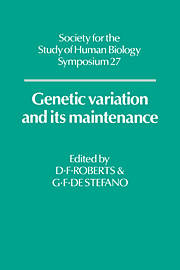Book contents
- Frontmatter
- Contents
- Preface
- Part I Genetic Diversity - Its Dimensions
- Part II Genetic Diversity - Its Origin and Maintenance
- Human genetic diversity in south-east Asia and the western Pacific
- Malaria-protective alleles in southern Africa: relict alleles of no health significance
- The genetic origin of the variability of the phenotypic expression of the Hb S gene
- Origin and maintenance of genetic variation in Black Carib populations of St. Vincent and Central America
- Historical and demographic factors and the genetic structure of an Afro-American Community of Nicaragua
- Migration and genetic polymorphisms in some Congo peoples
- Population structure studies and genetic variability in humans
- Inbreeding and the incidence of recessive disorders in the populations of Karnataka, South India
- Genetic diversity at the albumin locus
- GENETIC DIVERSITY - APPLICATIONS AND PROBLEMS OF COMPLEX CHARACTERS
- Index
Malaria-protective alleles in southern Africa: relict alleles of no health significance
Published online by Cambridge University Press: 05 March 2012
- Frontmatter
- Contents
- Preface
- Part I Genetic Diversity - Its Dimensions
- Part II Genetic Diversity - Its Origin and Maintenance
- Human genetic diversity in south-east Asia and the western Pacific
- Malaria-protective alleles in southern Africa: relict alleles of no health significance
- The genetic origin of the variability of the phenotypic expression of the Hb S gene
- Origin and maintenance of genetic variation in Black Carib populations of St. Vincent and Central America
- Historical and demographic factors and the genetic structure of an Afro-American Community of Nicaragua
- Migration and genetic polymorphisms in some Congo peoples
- Population structure studies and genetic variability in humans
- Inbreeding and the incidence of recessive disorders in the populations of Karnataka, South India
- Genetic diversity at the albumin locus
- GENETIC DIVERSITY - APPLICATIONS AND PROBLEMS OF COMPLEX CHARACTERS
- Index
Summary
INTRODUCTION
The history of the evolution of malaria is not known with any degree of certainty. It is found among all the major groups of terrestrial vertebrates in the Old World, suggesting that the parasites predate the hominids by millions of years. It has been claimed that plasmodial species evolved in tropical Africa or else in South-East Asia. Bruce-Chwatt (1965) pointed out that there were references to malaria dating back to 2000 BC and Hippocrates writing in the 5th Century BC was well aware of malarial fevers. There are also references to malarial fevers in the literature of India, and one writer went so far as to attribute them to mosquitos.
Prior to the 3rd Century BC, the entire population of sub-Saharan Africa consisted of small bands of hunter–gatherers. Such a low population density, coupled with the fact that such people were not tied to settlements near water holes, probably meant that malaria was nowhere hyperendemic. But by about 250 BC the Nok culture made its appearance in what is now northern Nigeria but extending both west and east at the same latitude. This belt was then probably wetter and more thickly wooded than it is today even though it was still to the north of the high forest. It was suitable for cereal growing, and the transition of people from the Stone Age into the Iron Age is thought to have taken place in that region. With farming implements made from iron, the people could cut trees and till the soil more effectively, and expand into the forest areas.
- Type
- Chapter
- Information
- Genetic Variation and its Maintenance , pp. 135 - 148Publisher: Cambridge University PressPrint publication year: 1986
- 2
- Cited by

